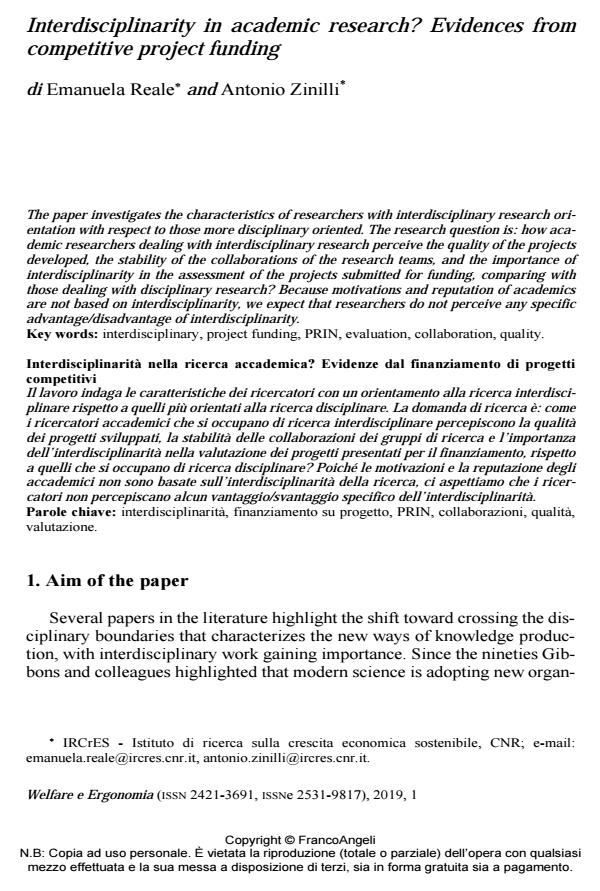Interdisciplinarity in academic research? Evidences from competitive project funding
Journal title WELFARE E ERGONOMIA
Author/s Emanuela Reale, Antonio Zinilli
Publishing Year 2020 Issue 2019/1 Language English
Pages 15 P. 79-93 File size 373 KB
DOI 10.3280/WE2019-001008
DOI is like a bar code for intellectual property: to have more infomation
click here
Below, you can see the article first page
If you want to buy this article in PDF format, you can do it, following the instructions to buy download credits

FrancoAngeli is member of Publishers International Linking Association, Inc (PILA), a not-for-profit association which run the CrossRef service enabling links to and from online scholarly content.
The paper investigates the characteristics of researchers with interdisciplinary research ori-entation with respect to those more disciplinary oriented. The research question is: how aca-demic researchers dealing with interdisciplinary research perceive the quality of the projects developed, the stability of the collaborations of the research teams, and the importance of in-terdisciplinarity in the assessment of the projects submitted for funding, comparing with those dealing with disciplinary research? Because motivations and reputation of academics are not based on interdisciplinarity, we expect that researchers do not perceive any specific ad-vantage/disadvantage of interdisciplinarity.
Keywords: Interdisciplinary, project funding, PRIN, evaluation, collaboration, quality.
- Boix Mansilla V., Feller I. and Gardner H. (2006). Quality assessment in interdisciplinary research evalaution. Research Evaluation, 15: 69-74.
- Bonaccorsi A. (2008). Search regimes and the industrial dynamics of science. Minerva, 46: 285-315.
- Carayol N. and Thi T.U. (2005). Why do academic scientists engage in interdisciplinary research? Research Evaluation, 70-79.
- Gibbons M., Limoges C., Nowotny H., Schwartzman S., Scott P. and Trow M. (1994). The new production of knowledge. London: Sage.
- Katz J.S. and Martin B. (1997). What is research collaboration. Research Policy, 26: 1-18.
- Klein J. (2008). Evaluation of interdisciplinarity and transdisciplinary research. American Journal of Preventive Medicine, 116-123.
- Langfeld L. (2006). The policy challenges of peer review: managing bias, conflict of interests and interdisciplinary assessment. Research Evaluation, 31- 41.
- Laudel G. (2006). Conclave in the Tower of Babel: how peers review interdisciplinary research proposals. Research Evaluation, 15: 57-6.
- Reale E. e Zinilli A. (2016). La valutazione dei Programmi di ricerca di interesse nazionale PRIN: quali criteri usa la comunità scientifica? RIV - Rassegna Italiana di Valutazione, 64(2016): 27-52. DOI: 10.3280/RIV2016-064003
- Ribeiro F.M. (2016). Interdisciplinarity in ferment: the role of knowledge networks and department affiliation. Technological Forecasting and Social Change, 113(B): 240-247.
- Sanz-Menendez L., Zulueta García M.Á. and Bordons M. (2001). Interdisciplinarity as a multidimensional concept: measures in three different areas. Research Evaluation, 47-58.
- van Raan T. (2000). Practising Interdisciplinarity. Canada: University of Toronto Press.
- Wooley R., Sánchez-Barrioluengo M., Turpin T. and Marceau J. (2015). Research collaborations in the social sciences: What factors are associated with disciplinary and interdisciplinary collaborations? Science and Public Policy, 42(4).
- Zinilli A. (2016). Competitive project funding and dynamic complex networks: evidence from Projects of National Interest (PRIN). Scientometrics, 108: 633-652.
Emanuela Reale, Antonio Zinilli, Interdisciplinarity in academic research? Evidences from competitive project funding in "WELFARE E ERGONOMIA" 1/2019, pp 79-93, DOI: 10.3280/WE2019-001008